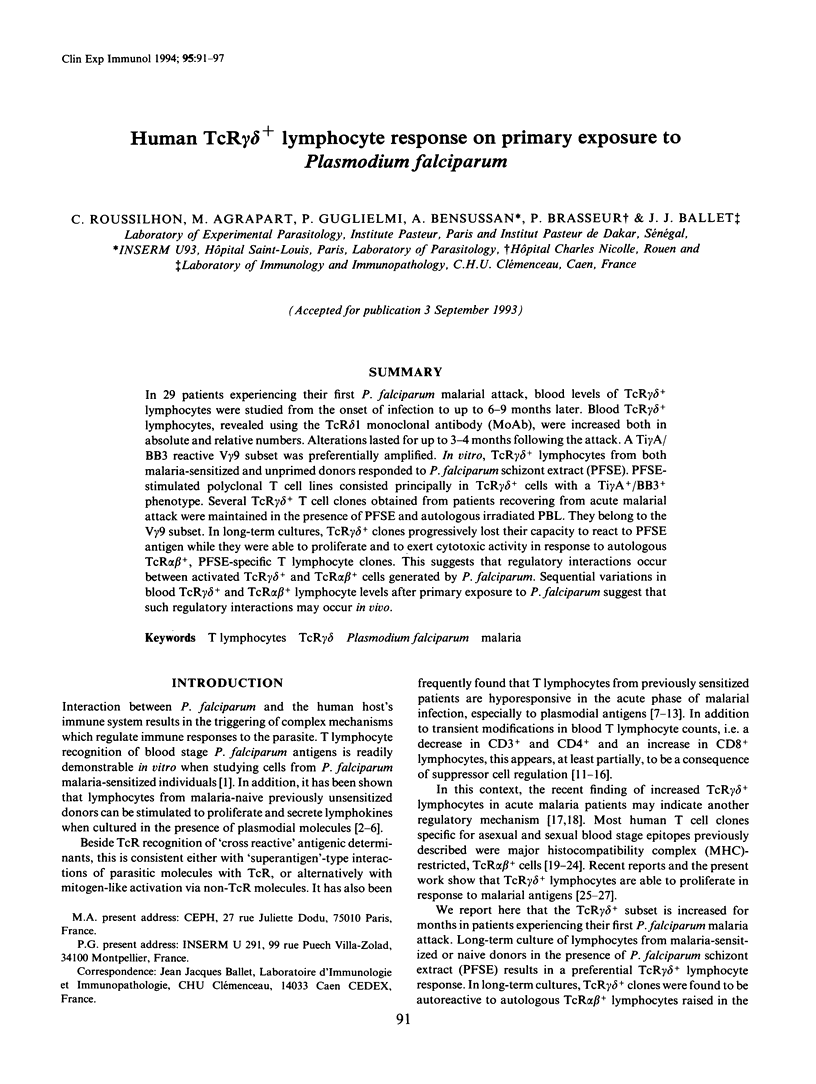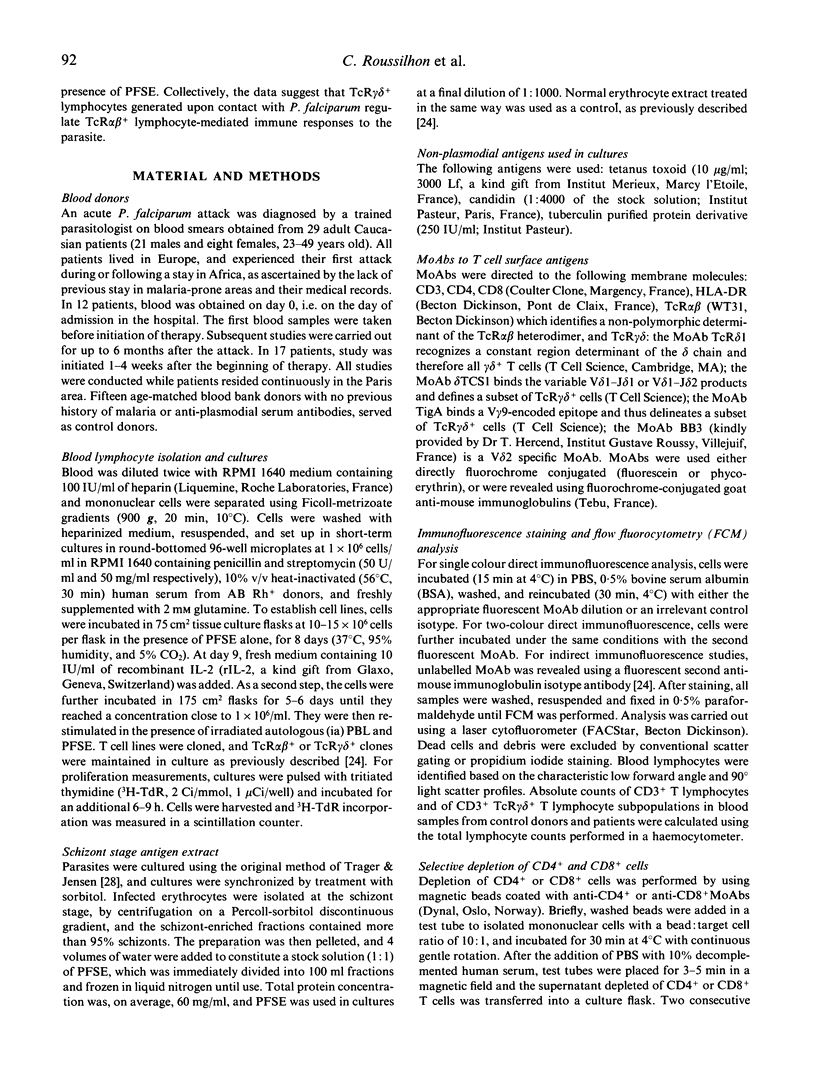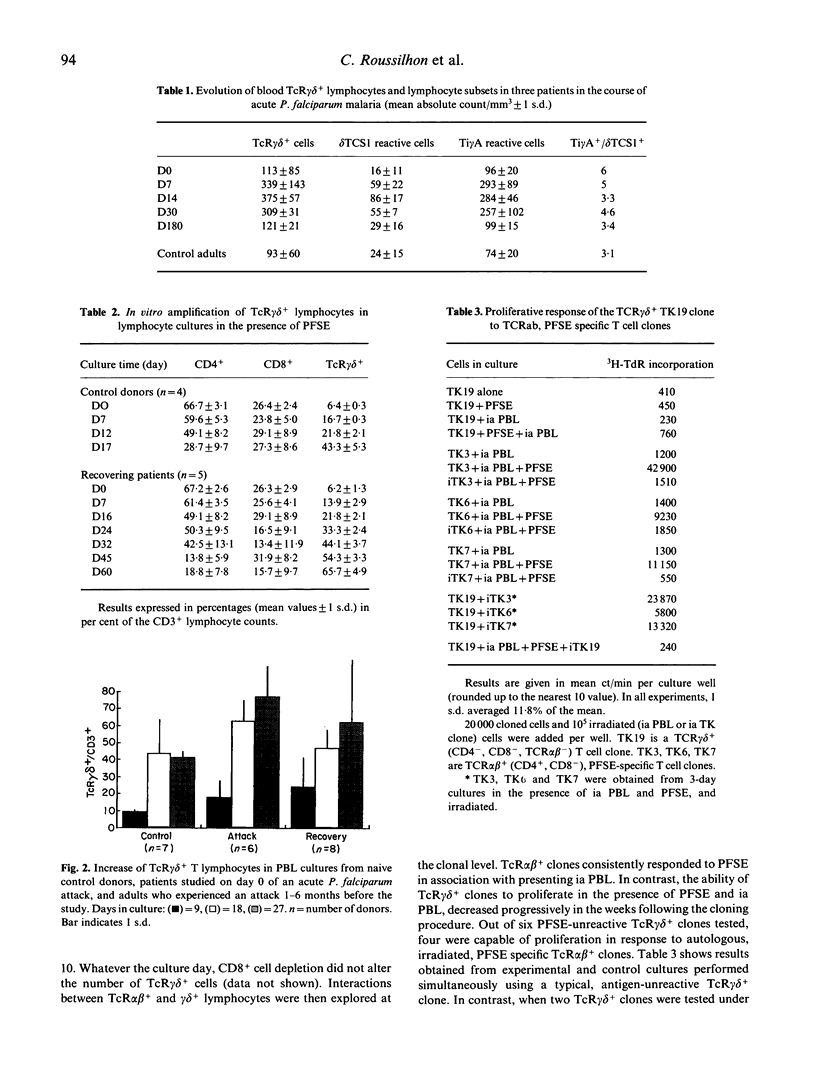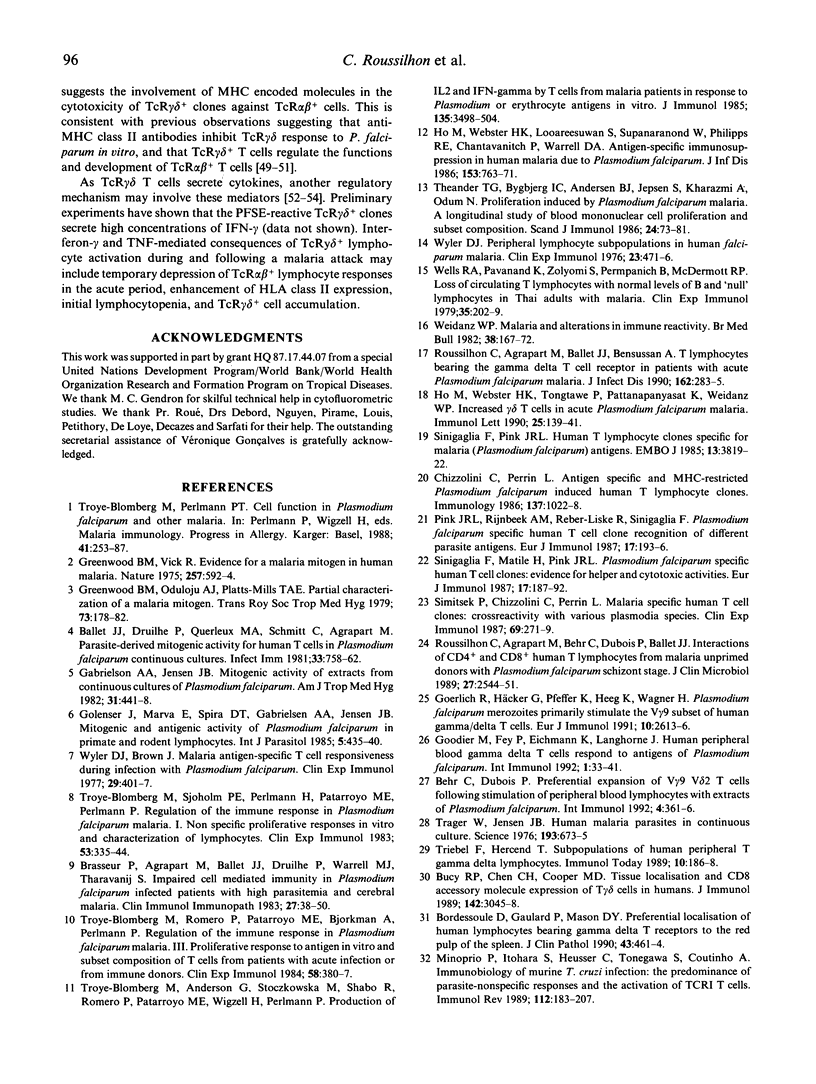Abstract
In 29 patients experiencing their first P. falciparum malarial attack, blood levels of TcR gamma delta+ lymphocytes were studied from the onset of infection to up to 6-9 months later. Blood TcR gamma delta+ lymphocytes, revealed using the TcR delta 1 monoclonal antibody (MoAb), were increased both in absolute and relative numbers. Alterations lasted for up to 3-4 months following the attack. A Ti gamma A/BB3 reactive V gamma 9 subset was preferentially amplified. In vitro, TcR gamma delta+ lymphocytes from both malaria-sensitized and unprimed donors responded to P. falciparum schizont extract (PFSE). PFSE-stimulated polyclonal T cell lines consisted principally in TcR gamma delta+ cells with a Ti gamma A+/BB3+ phenotype. Several TcR gamma delta+ T cell clones obtained from patients recovering from acute malarial attack were maintained in the presence of PFSE and autologous irradiated PBL. They belong to the V gamma 9 subset. In long-term cultures, TcR gamma delta+ clones progressively lost their capacity to react to PFSE antigen while they were able to proliferate and to exert cytotoxic activity in response to autologous TcR alpha beta+, PFSE-specific T lymphocyte clones. This suggests that regulatory interactions occur between activated TcR gamma delta+ and TcR alpha beta+ cells generated by P. falciparum. Sequential variations in blood TcR gamma delta+ and TcR alpha beta+ lymphocyte levels after primary exposure to P. falciparum suggest that such regulatory interactions may occur in vivo.
Full text
PDF






Selected References
These references are in PubMed. This may not be the complete list of references from this article.
- Balbi B., Moller D. R., Kirby M., Holroyd K. J., Crystal R. G. Increased numbers of T lymphocytes with gamma delta-positive antigen receptors in a subgroup of individuals with pulmonary sarcoidosis. J Clin Invest. 1990 May;85(5):1353–1361. doi: 10.1172/JCI114579. [DOI] [PMC free article] [PubMed] [Google Scholar]
- Ballet J. J., Druilhe P., Querleux M. A., Schmitt C., Agrapart M. Parasite-derived mitogenic activity for human T cells in Plasmodium falciparum continuous cultures. Infect Immun. 1981 Sep;33(3):758–762. doi: 10.1128/iai.33.3.758-762.1981. [DOI] [PMC free article] [PubMed] [Google Scholar]
- Behr C., Dubois P. Preferential expansion of V gamma 9 V delta 2 T cells following stimulation of peripheral blood lymphocytes with extracts of Plasmodium falciparum. Int Immunol. 1992 Mar;4(3):361–366. doi: 10.1093/intimm/4.3.361. [DOI] [PubMed] [Google Scholar]
- Bensussan A., David V., Vilmer E., Leca G., Boumsell L. Immunodeficiency after bone marrow transplantation can be associated with autoreactive T-cell receptor gamma delta-bearing lymphocytes. Immunol Rev. 1990 Aug;116:5–13. doi: 10.1111/j.1600-065x.1990.tb00801.x. [DOI] [PubMed] [Google Scholar]
- Bolhuis R. L., Sturm E., Fisch P., Sondel P. M., Braakman E. Human gamma delta T lymphocyte subsets: activation by superantigens? Res Immunol. 1990 Sep;141(7):658–663. doi: 10.1016/0923-2494(90)90077-c. [DOI] [PubMed] [Google Scholar]
- Bordessoule D., Gaulard P., Mason D. Y. Preferential localisation of human lymphocytes bearing gamma delta T cell receptors to the red pulp of the spleen. J Clin Pathol. 1990 Jun;43(6):461–464. doi: 10.1136/jcp.43.6.461. [DOI] [PMC free article] [PubMed] [Google Scholar]
- Born W., Happ M. P., Dallas A., Reardon C., Kubo R., Shinnick T., Brennan P., O'Brien R. Recognition of heat shock proteins and gamma delta cell function. Immunol Today. 1990 Feb;11(2):40–43. doi: 10.1016/0167-5699(90)90015-2. [DOI] [PubMed] [Google Scholar]
- Borst J., Wicherink A., Van Dongen J. J., De Vries E., Comans-Bitter W. M., Wassenaar F., Van Den Elsen P. Non-random expression of T cell receptor gamma and delta variable gene segments in functional T lymphocyte clones from human peripheral blood. Eur J Immunol. 1989 Sep;19(9):1559–1568. doi: 10.1002/eji.1830190907. [DOI] [PubMed] [Google Scholar]
- Brasseur P., Agrapart M., Ballet J. J., Druilhe P., Warrell M. J., Tharavanij S. Impaired cell-mediated immunity in Plasmodium falciparum-infected patients with high-parasitemia and cerebral malaria. Clin Immunol Immunopathol. 1983 Apr;27(1):38–50. doi: 10.1016/0090-1229(83)90054-5. [DOI] [PubMed] [Google Scholar]
- Bucy R. P., Chen C. L., Cooper M. D. Tissue localization and CD8 accessory molecule expression of T gamma delta cells in humans. J Immunol. 1989 May 1;142(9):3045–3049. [PubMed] [Google Scholar]
- Chizzolini C., Perrin L. Antigen-specific and MHC-restricted Plasmodium falciparum-induced human T lymphocyte clones. J Immunol. 1986 Aug 1;137(3):1022–1028. [PubMed] [Google Scholar]
- Faure F., Jitsukawa S., Meuer S., Bohuon C., Triebel F., Hercend T. Identification of a CD2- CD3+ T cell receptor-gamma+ peripheral blood lymphocyte subpopulation. J Immunol. 1988 Apr 1;140(7):2128–2132. [PubMed] [Google Scholar]
- Ferrini S., Prigione I., Bottino C., Ciccone E., Tambussi G., Mammoliti S., Moretta L., Moretta A. Monoclonal antibodies which react with the T cell receptor gamma/delta recognize different subsets of CD3+WT31- T lymphocytes. Eur J Immunol. 1989 Jan;19(1):57–61. doi: 10.1002/eji.1830190110. [DOI] [PubMed] [Google Scholar]
- Gabrielsen A. A., Jr, Jensen J. B. Mitogenic activity of extracts from continuous cultures of Plasmodium falciparum. Am J Trop Med Hyg. 1982 May;31(3 Pt 1):441–448. doi: 10.4269/ajtmh.1982.31.441. [DOI] [PubMed] [Google Scholar]
- Goerlich R., Häcker G., Pfeffer K., Heeg K., Wagner H. Plasmodium falciparum merozoites primarily stimulate the V gamma 9 subset of human gamma/delta T cells. Eur J Immunol. 1991 Oct;21(10):2613–2616. doi: 10.1002/eji.1830211045. [DOI] [PubMed] [Google Scholar]
- Golenser J., Marva E., Spira D. T., Gabrielsen A. A., Jensen J. B. Mitogenic and antigenic activity of Plasmodium falciparum in primate and rodent lymphocytes. Int J Parasitol. 1985 Aug;15(4):435–440. doi: 10.1016/0020-7519(85)90030-x. [DOI] [PubMed] [Google Scholar]
- Goodier M., Fey P., Eichmann K., Langhorne J. Human peripheral blood gamma delta T cells respond to antigens of Plasmodium falciparum. Int Immunol. 1992 Jan;4(1):33–41. doi: 10.1093/intimm/4.1.33. [DOI] [PubMed] [Google Scholar]
- Goodier M., Krause-Jauer M., Langhorne J. Quantitative analysis of the response of human T cell receptor V gamma 9+ cells to Plasmodium falciparum. Eur J Immunol. 1992 Oct;22(10):2757–2760. doi: 10.1002/eji.1830221045. [DOI] [PubMed] [Google Scholar]
- Greenwood B. M., Oduloju A. J., Platts-Mills T. A. Partial characterization of a malaria mitogen. Trans R Soc Trop Med Hyg. 1979;73(2):178–182. doi: 10.1016/0035-9203(79)90204-9. [DOI] [PubMed] [Google Scholar]
- Greenwood B. M., Vick R. M. Evidence for a malaria mitogen in human malaria. Nature. 1975 Oct 16;257(5527):592–594. doi: 10.1038/257592a0. [DOI] [PubMed] [Google Scholar]
- Ho M., Webster H. K., Looareesuwan S., Supanaranond W., Phillips R. E., Chanthavanich P., Warrell D. A. Antigen-specific immunosuppression in human malaria due to Plasmodium falciparum. J Infect Dis. 1986 Apr;153(4):763–771. doi: 10.1093/infdis/153.4.763. [DOI] [PubMed] [Google Scholar]
- Ho M., Webster H. K., Tongtawe P., Pattanapanyasat K., Weidanz W. P. Increased gamma delta T cells in acute Plasmodium falciparum malaria. Immunol Lett. 1990 Aug;25(1-3):139–141. doi: 10.1016/0165-2478(90)90105-y. [DOI] [PubMed] [Google Scholar]
- Holoshitz J., Koning F., Coligan J. E., De Bruyn J., Strober S. Isolation of CD4- CD8- mycobacteria-reactive T lymphocyte clones from rheumatoid arthritis synovial fluid. Nature. 1989 May 18;339(6221):226–229. doi: 10.1038/339226a0. [DOI] [PubMed] [Google Scholar]
- Janis E. M., Kaufmann S. H., Schwartz R. H., Pardoll D. M. Activation of gamma delta T cells in the primary immune response to Mycobacterium tuberculosis. Science. 1989 May 12;244(4905):713–716. doi: 10.1126/science.2524098. [DOI] [PubMed] [Google Scholar]
- Jones K. R., Hickling J. K., Targett G. A., Playfair J. H. Polyclonal in vitro proliferative responses from nonimmune donors to Plasmodium falciparum malaria antigens require UCHL1+ (memory) T cells. Eur J Immunol. 1990 Feb;20(2):307–315. doi: 10.1002/eji.1830200212. [DOI] [PubMed] [Google Scholar]
- Kabelitz D., Pechhold K., Bender A., Wesselborg S., Wesch D., Friese K., Janssen O. Activation and activation-driven death of human gamma/delta T cells. Immunol Rev. 1991 Apr;120:71–88. doi: 10.1111/j.1600-065x.1991.tb00588.x. [DOI] [PubMed] [Google Scholar]
- Langhorne J., Goodier M., Behr C., Dubois P. Is there a role for gamma delta T cells in malaria? Immunol Today. 1992 Aug;13(8):298–300. doi: 10.1016/0167-5699(92)90041-5. [DOI] [PubMed] [Google Scholar]
- Minoprio P., Itohara S., Heusser C., Tonegawa S., Coutinho A. Immunobiology of murine T. cruzi infection: the predominance of parasite-nonspecific responses and the activation of TCRI T cells. Immunol Rev. 1989 Dec;112:183–207. doi: 10.1111/j.1600-065x.1989.tb00558.x. [DOI] [PubMed] [Google Scholar]
- Miyawaki T., Kasahara Y., Taga K., Yachie A., Taniguchi N. Differential expression of CD45RO (UCHL1) and its functional relevance in two subpopulations of circulating TCR-gamma/delta+ lymphocytes. J Exp Med. 1990 May 1;171(5):1833–1838. doi: 10.1084/jem.171.5.1833. [DOI] [PMC free article] [PubMed] [Google Scholar]
- Modlin R. L., Pirmez C., Hofman F. M., Torigian V., Uyemura K., Rea T. H., Bloom B. R., Brenner M. B. Lymphocytes bearing antigen-specific gamma delta T-cell receptors accumulate in human infectious disease lesions. Nature. 1989 Jun 15;339(6225):544–548. doi: 10.1038/339544a0. [DOI] [PubMed] [Google Scholar]
- Morio T., Nagasawa M., Nonoyama S., Okawa H., Yata J. Phenotypic profile and functions of T cell receptor-gamma delta-bearing cells from patients with primary immunodeficiency syndrome. J Immunol. 1990 Feb 15;144(4):1270–1275. [PubMed] [Google Scholar]
- O'Brien R. L., Happ M. P., Dallas A., Palmer E., Kubo R., Born W. K. Stimulation of a major subset of lymphocytes expressing T cell receptor gamma delta by an antigen derived from Mycobacterium tuberculosis. Cell. 1989 May 19;57(4):667–674. doi: 10.1016/0092-8674(89)90135-9. [DOI] [PubMed] [Google Scholar]
- Patel S. S., Wacholtz M. C., Duby A. D., Thiele D. L., Lipsky P. E. Analysis of the functional capabilities of CD3+CD4-CD8- and CD3+CD4+CD8+ human T cell clones. J Immunol. 1989 Aug 15;143(4):1108–1117. [PubMed] [Google Scholar]
- Pink J. R., Rijnbeek A. M., Reber-Liske R., Sinigaglia F. Plasmodium falciparum-specific human T cell clones: recognition of different parasite antigens. Eur J Immunol. 1987 Feb;17(2):193–196. doi: 10.1002/eji.1830170207. [DOI] [PubMed] [Google Scholar]
- Qvigstad E., Bosnes V., Lundin K. E., Thorsby E. Specificity of two subsets of cytotoxic human gamma delta T-cell clones. Scand J Immunol. 1990 Aug;32(2):129–135. doi: 10.1111/j.1365-3083.1990.tb02902.x. [DOI] [PubMed] [Google Scholar]
- Roussilhon C., Agrapart M., Ballet J. J., Bensussan A. T lymphocytes bearing the gamma delta T cell receptor in patients with acute Plasmodium falciparum malaria. J Infect Dis. 1990 Jul;162(1):283–285. doi: 10.1093/infdis/162.1.283-a. [DOI] [PubMed] [Google Scholar]
- Roussilhon C., Agrapart M., Behr C., Dubois P., Ballet J. J. Interactions of CD4+ and CD8+ human T lymphocytes from malaria-unprimed donors with Plasmodium falciparum schizont stage. J Clin Microbiol. 1989 Nov;27(11):2544–2551. doi: 10.1128/jcm.27.11.2544-2551.1989. [DOI] [PMC free article] [PubMed] [Google Scholar]
- Rust C. J., Verreck F., Vietor H., Koning F. Specific recognition of staphylococcal enterotoxin A by human T cells bearing receptors with the V gamma 9 region. Nature. 1990 Aug 9;346(6284):572–574. doi: 10.1038/346572a0. [DOI] [PubMed] [Google Scholar]
- Simitsek P., Chizzolini C., Perrin L. Malaria specific human T cell clones: crossreactivity with various plasmodia species. Clin Exp Immunol. 1987 Aug;69(2):271–279. [PMC free article] [PubMed] [Google Scholar]
- Sinigaglia F., Matile H., Pink J. R. Plasmodium falciparum-specific human T cell clones: evidence for helper and cytotoxic activities. Eur J Immunol. 1987 Feb;17(2):187–192. doi: 10.1002/eji.1830170206. [DOI] [PubMed] [Google Scholar]
- Sinigaglia F., Richard J., Pink L. Human T lymphocyte clones specific for malaria (Plasmodium falciparum) antigens. EMBO J. 1985 Dec 30;4(13B):3819–3822. doi: 10.1002/j.1460-2075.1985.tb04153.x. [DOI] [PMC free article] [PubMed] [Google Scholar]
- Sumida T., Maeda T., Takahashi H., Yoshida S., Yonaha F., Sakamoto A., Tomioka H., Koike T., Yoshida S. Predominant expansion of V gamma 9/V delta 2 T cells in a tularemia patient. Infect Immun. 1992 Jun;60(6):2554–2558. doi: 10.1128/iai.60.6.2554-2558.1992. [DOI] [PMC free article] [PubMed] [Google Scholar]
- Tamura N., Holroyd K. J., Banks T., Kirby M., Okayama H., Crystal R. G. Diversity in junctional sequences associated with the common human V gamma 9 and V delta 2 gene segments in normal blood and lung compared with the limited diversity in a granulomatous disease. J Exp Med. 1990 Jul 1;172(1):169–181. doi: 10.1084/jem.172.1.169. [DOI] [PMC free article] [PubMed] [Google Scholar]
- Theander T. G., Bygbjerg I. C., Andersen B. J., Jepsen S., Kharazmi A., Odum N. Suppression of parasite-specific response in Plasmodium falciparum malaria. A longitudinal study of blood mononuclear cell proliferation and subset composition. Scand J Immunol. 1986 Jul;24(1):73–81. doi: 10.1111/j.1365-3083.1986.tb02071.x. [DOI] [PubMed] [Google Scholar]
- Trager W., Jensen J. B. Human malaria parasites in continuous culture. Science. 1976 Aug 20;193(4254):673–675. doi: 10.1126/science.781840. [DOI] [PubMed] [Google Scholar]
- Triebel F., Hercend T. Subpopulations of human peripheral T gamma delta lymphocytes. Immunol Today. 1989 Jun;10(6):186–188. doi: 10.1016/0167-5699(89)90321-6. [DOI] [PubMed] [Google Scholar]
- Troye-Blomberg M., Andersson G., Stoczkowska M., Shabo R., Romero P., Patarroyo M. E., Wigzell H., Perlmann P. Production of IL 2 and IFN-gamma by T cells from malaria patients in response to Plasmodium falciparum or erythrocyte antigens in vitro. J Immunol. 1985 Nov;135(5):3498–3504. [PubMed] [Google Scholar]
- Troye-Blomberg M., Romero P., Patarroyo M. E., Björkman A., Perlmann P. Regulation of the immune response in Plasmodium falciparum malaria. III. Proliferative response to antigen in vitro and subset composition of T cells from patients with acute infection or from immune donors. Clin Exp Immunol. 1984 Nov;58(2):380–387. [PMC free article] [PubMed] [Google Scholar]
- Troye-Blomberg M., Sjöholm P. E., Perlmann H., Patarroyo M. E., Perlmann P. Regulation of the immune response in Plasmodium falciparum malaria. I. Non-specific proliferative responses in vitro and characterization of lymphocytes. Clin Exp Immunol. 1983 Aug;53(2):335–344. [PMC free article] [PubMed] [Google Scholar]
- Weidanz W. P. Malaria and alterations in immune reactivity. Br Med Bull. 1982 May;38(2):167–172. doi: 10.1093/oxfordjournals.bmb.a071754. [DOI] [PubMed] [Google Scholar]
- Wells R. A., Pavanand K., Zolyomi S., Permpanich B., MacDermott R. P. Loss of circulating T lymphocytes with normal levels of B and 'null' lymphocytes in Thai adults with malaria. Clin Exp Immunol. 1979 Feb;35(2):202–209. [PMC free article] [PubMed] [Google Scholar]
- Wyler D. J., Brown J. Malaria antigen-specific T-cell responsiveness during infection with Plasmodium falciparum. Clin Exp Immunol. 1977 Sep;29(3):401–407. [PMC free article] [PubMed] [Google Scholar]
- Wyler D. J. Peripheral lymphocyte subpopulations in human falciparum malaria. Clin Exp Immunol. 1976 Mar;23(3):471–476. [PMC free article] [PubMed] [Google Scholar]


